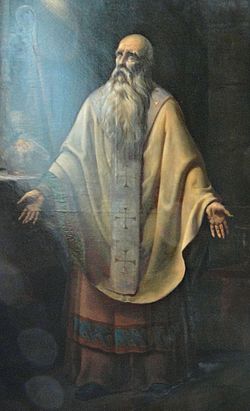Saint Magloire
| St. Magloire | |
|---|---|

Saint Magloire of Dol, oil painting by Eugène Goyet (1798–1846), Church Saint-Jacques-du-Haut-Pas in Paris
|
|
| Died | 575 |
| Venerated in | Roman Catholicism, Orthodox Christianity |
| Feast | October 24 |
Magloire, better known as Saint Magloire of Dol, is a Breton saint, one of a number attributed an origin the other side of the English Channel. Magloire was a Welsh monk who became Bishop of Dol-de-Bretagne in Brittany, and ended his life on the island of Sark, where he was abbot of a monastery.
Magloire was born in the early 6th century. His mother was a Welsh Princess, his father a Breton nobleman. From the age of 5, he studied at the monastery at Llantwit Major under the tutelage of St Illtud. After his ordination he was made Abbot of a monastery at Lammeur in Brittany, where he governed with prudence and holiness for 52 years. He is traditionally given to be a cousin of Samson of Dol, and his successor as bishop of Dol at the end of the 7th century. He remained there for only two or three years, and then after receiving instructions from a visiting angel, he resigned his post to Budoc, and in 565 withdrew to the island of Sark where he established a community of 62 monks.
He died about the year 575.
Several miracles are attributed to St Magloire and as a result of these, he acquired much land. He had been given the entire Island of Jersey by the Seigneur Count Lois Escon who had been gravely ill and was miraculously cured by Magloire. Then Nivo, the owner of Guernsey asked for his help in curing his daughter who was deaf and dumb, and for this Magloire was granted a third of Guernsey. He was also given half the Island of Sark by Loyesco of Brittany in return for curing his leprosy.
One of the most well known stories about him concerns his rescue of a group of children who were playing on the beach below the monks water mill in an abandoned wreck, when a sudden violent storm swept them out to sea. Hearing their cries for help, Magloire is said to have transported himself out to sea and saved them and their small boat, steering it to the safety of a Breton cove before vanishing.
Contemporary opinion is that he was an Irish abbot, who died c. 575.
A Latin Vita Sancti Maglorii exists, of uncertain provenance. François Duine (1874–1924) called this work a masterpiece of ancient Breton literature. Scholars place its composition between the later 9th century and the middle of the 10th century.
...
Wikipedia
